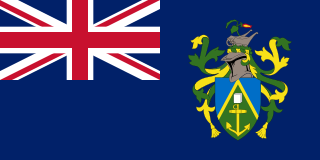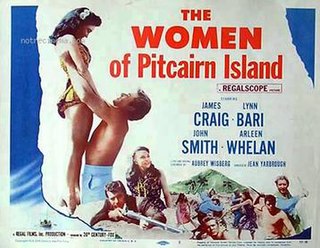Related Research Articles

The Pitcairn Islands, officially Pitcairn, Henderson, Ducie and Oeno Islands, are a group of four volcanic islands in the southern Pacific Ocean that form the sole British Overseas Territory in the Pacific Ocean. The four islands—Pitcairn, Henderson, Ducie and Oeno—are scattered across several hundred miles of ocean and have a combined land area of about 18 square miles (47 km2). Henderson Island accounts for 86% of the land area, but only Pitcairn Island is inhabited. The inhabited islands nearest to the Pitcairn Islands are Mangareva, 688 km to the west, as well as Easter Island, 1,929 km to the east.

The Pitcairn Islands are a British Overseas Territory in the South Pacific Ocean, with a population of about 50. The politics of the islands takes place in a framework of a parliamentary representative democratic dependency, whereby the Mayor is the head of government. The territory's constitution is the Local Government Ordinance of 1964. In terms of population, the Pitcairn Islands is the smallest democracy in the world.

The mutiny on the Royal Navy vessel HMS Bounty occurred in the South Pacific Ocean on 28 April 1789. Disaffected crewmen, led by acting-Lieutenant Fletcher Christian, seized control of the ship from their captain, Lieutenant William Bligh, and set him and eighteen loyalists adrift in the ship's open launch. The reasons behind the mutiny are still debated. Bligh and his crew stopped for supplies on Tofua, losing a man to natives. Bligh navigated more than 3,500 nautical miles in the launch to reach safety and began the process of bringing the mutineers to justice. The mutineers variously settled on Tahiti or on Pitcairn Island.

Adamstown is the capital of the Pitcairn Islands, and the only settlement on the Pitcairn Islands, the only British Overseas Territory that is located in the southern Pacific Ocean.

The history of the Pitcairn Islands begins with the colonization of the islands by Polynesians in the 11th century. Polynesian people established a culture that flourished for four centuries and then vanished. They lived on Pitcairn and Henderson Islands, and on Mangareva Island 540 kilometres (340 mi) to the northwest, for about 400 years.

Fletcher Christian was a British sailor who led the mutiny on the Bounty in 1789, during which he seized command of the Royal Navy vessel HMS Bounty from Lieutenant William Bligh.
Steven Raymond Christian is a politician, convicted sex offender and child rapist from the Pitcairn Islands. He was mayor of the islands from 1999 until 2004, when he was removed from office after being found guilty in the Pitcairn child sexual abuse trial.
In 2004, seven men living on Pitcairn Island faced 55 charges relating to sexual offences against children and young adults. The accused represented a third of the island's male population and included Steve Christian, the mayor. On 24 October, all but one of the defendants were found guilty on at least some of the charges. Another six men living abroad, including Shawn Christian, who later served as mayor of Pitcairn, were tried on 41 charges in a separate trial in Auckland, New Zealand, in 2005.

The Island Council is the legislature of the Pitcairn Islands.
Brenda Vera Amelia Lupton-Christian is a political figure from the Pacific territory of the Pitcairn Islands. When her brother Steve Christian was removed from the office of mayor following the 2004 Pitcairn child sexual abuse trial, she served as interim mayor of the islands.

.pn is the Internet country code top-level domain (ccTLD) for the Pitcairn Islands.

Thursday October Christian II was a Pitcairn Islands political leader. He was the grandson of Fletcher Christian and son of Thursday October Christian, and mother, Teraura. He was also known as "Doctor", "Duddie" or "Doodie". He spent several years on Norfolk Island but returned to Pitcairn in 1864. Christian was three quarters Polynesian.

The descendants of the Bounty mutineers include the modern-day Pitcairn Islanders as well as a little less than half of the population of Norfolk Island. Their common ancestors were the nine surviving mutineers from the mutiny on HMS Bounty which occurred in the south Pacific Ocean in 1789. Their descendants also live in New Zealand, Australia, and the United States.
Pitcairn Islanders, also referred to as Pitkerners and Pitcairnese, are the native inhabitants of the Pitcairn Islands, a British Overseas Territory including people whose families were previously inhabitants and maintaining cultural connections. Most Pitcairn Islanders are descendants of the Bounty mutineers.
Shawn Brent Christian is a Pitcairnese politician, who served as Mayor of the Pitcairn Islands between 2014 and 2019. He previously served in prison after being convicted of child rape.

The complement of HMS Bounty, the Royal Navy ship on which a historic mutiny occurred in the south Pacific on 28 April 1789, comprised 46 men on its departure from England in December 1787 and 44 at the time of the mutiny, including her commander Lieutenant William Bligh. All but two of those aboard were Royal Navy personnel; the exceptions were two civilian botanists engaged to supervise the breadfruit plants Bounty was tasked to take from Tahiti to the West Indies. Of the 44 aboard at the time of the mutiny, 19 were set adrift in the ship's launch, while 25, a mixture of mutineers and detainees, remained on board under Fletcher Christian. Bligh led his loyalists 3,500 nautical miles to safety in the open boat, and ultimately back to England. The mutineers divided—most settled on Tahiti, where they were captured by HMS Pandora in 1791 and returned to England for trial, while Christian and eight others evaded discovery on Pitcairn Island.

The Women of Pitcairn Island is a 1956 American adventure drama film directed by Jean Yarbrough and starring Lynn Bari, John Smith and Sue England. It was produced by Robert L. Lippert Regal Films for distribution by 20th Century Fox. The film's sets were designed by the art director Dave Milton.
Richard Edgar Christian was a Pitcairn Islander. He served as Chief Magistrate of Pitcairn in three spells between 1926 and 1940, and was also the island's first postmaster.
Arthur Herbert Young was a Pitcairn Islander. He served as Chief Magistrate of Pitcairn in four spells between 1907 and 1941.

Teraura, also Susan or Susannah Young, was a Tahitian woman who settled on Pitcairn Island with the Bounty Mutineers. She took part in Ned Young's plot to murder male Polynesians who had travelled on HMS Bounty and killed Tetahiti. A tapa maker, examples of her craft are found in the British Museum and at Kew Gardens.
References
- ↑ Pervis Ferris Young The Peerage